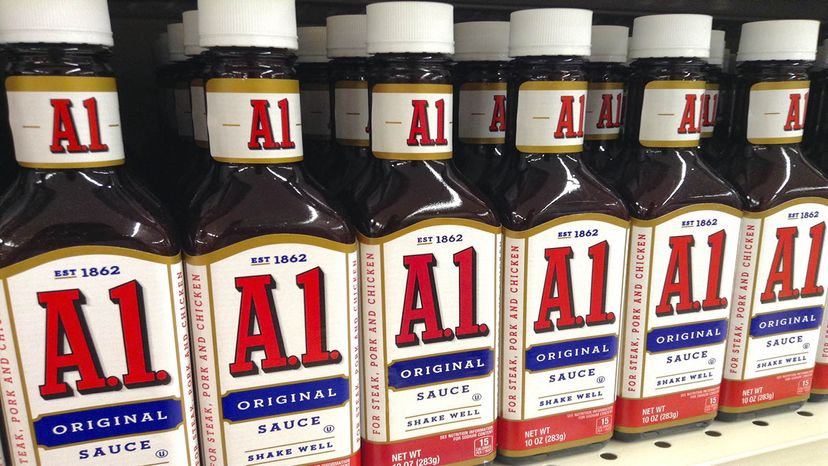“
 “The word "steak" was dropped from the steak sauce brand’s name in 2014 by Kraft Foods Group, which began promoting it as a sauce that can go with almost everything, from steak to fish to chicken. Mike Mozart/Flickr (CC BY 2.0)
“The word "steak" was dropped from the steak sauce brand’s name in 2014 by Kraft Foods Group, which began promoting it as a sauce that can go with almost everything, from steak to fish to chicken. Mike Mozart/Flickr (CC BY 2.0)
Our story begins in England somewhere between the years of 1824 and 1831, where a private chef to King George IV, named Henderson William Brand, concocted a sauce that grabbed the attention of the monarch. George loved the thick brown sauce, purportedly rating it an "A1," a move that cemented the fate of Brand and millions of steaks to come.
In 1831, Brand’s sauce went into commercial production, marketed as a condiment for "fish, meat and fowl," not to mention a sauce "appreciated on Welsh rarebits, broiled lobster and English mutton chops." At the 1862 International Exhibition in London, Brand introduced "Brand’s International Sauce" made of vinegar, Eastern spices, raisins, sultanas, dates, oranges and tomatoes.
By 1865, A.1. earned its place as the house sauce of the royals — and it wouldn’t be until the late 1890s that this acclaimed condiment would leap into the mainstream with a hold of over 50 percent of the British bottled sauce market. A.1.’s relationship with steak isn’t as long or illustrious as we may think it is, only marketed as a sauce for steak upon its arrival in the U.S. around 1906. In 1960, the company sealed their sauce’s fate by changing A.1.’s official name to "A.1. Steak Sauce."
Like most food products that have been around since the time before preservatives, A.1.’s ingredients have slightly changed since the 1800s. Now, the fresh tomatoes and raisins are replaced with purees and pastes, and mixed with spirit vinegar, corn syrup, crushed orange purée, salt, spices, celery seed, caramel color, potassium sorbate and delicious xanthan gum.
If you’ve never tasted A.1. before, you’ll notice a sweetness that you don’t get from condiments like ketchup. It’s tart and robust, with a peppery taste reminiscent of Worcestershire sauce.
Why the raisins? Not only do they add more than flavor, but legend has it the antioxidant-rich fruits were used to mask the flavor of rancid meat. To think, that was just something people were OK with back then. What a time to have been alive.
In 2014, Kraft dropped the word "steak" from the name to "reflect modern dining habits," even going as far as to release a surprisingly on-point video to announce the separation between sauce and steak.
If you want some sauce without making the trip to the store, A.1. is easy to make at home. Add water, golden raisins, balsamic vinegar, Worcestershire sauce, ketchup, dijon mustard, pepper, garlic, onion, celery, salt and orange in a saucepan and simmer for 15 minutes. Let cool, strain and drown your steak in sauce.
Now That’s Saucy
In 2017, employees of the public library in Avon Lake, Ohio, began finding clean, empty, labelless A.1. bottles stashed in the stacks, around 40 of them all together. It was theorized that someone might have been smuggling alcohol into the staid environs of the library in the square brown bottles, but a sniff test identified traces of A.1. in the bottles, not booze. The library’s video surveillence equipment failed to catch the culprit, and nobody was ever pinned with the "crime."


